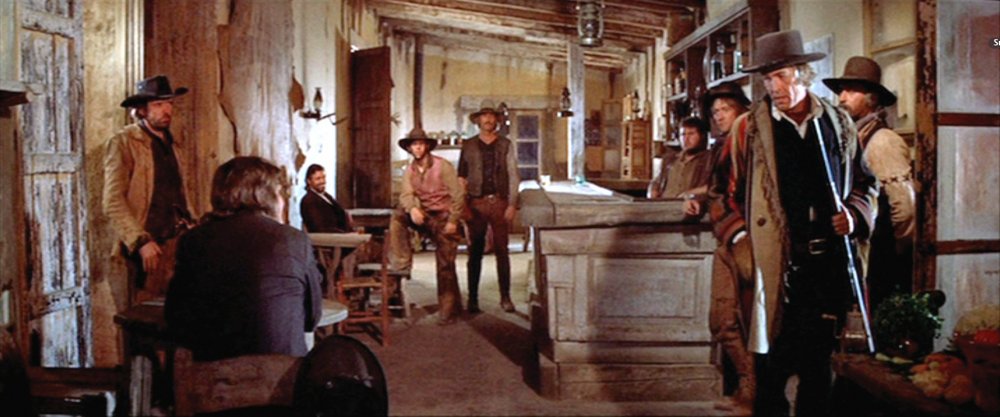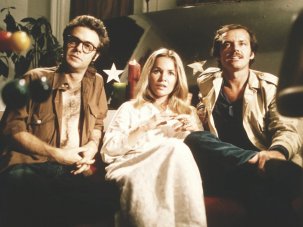from our December 2012 issue

Pat Garrett and Billy the Kid (1973)
Over the last few years, I’ve frequently pondered Jacques Rivette’s claim:
“All films are about the theatre, there is no other subject… Because that is the subject of truth and lies, and there is no other in the cinema: it is necessarily a questioning about truth, with means that are necessarily untruthful… Taking [performance] as the subject of a film is being frank, so it must be done.”
(Cahiers du cinéma 204, September 1968)
As anyone who follows my work – notably my book on Abel Ferrara and my Sight & Sound article on Woody Allen (April 2011) – will probably have realised, I’ve become increasingly focused on questions of performance and identity, a focus not limited to films dealing explicitly with theatrical activities. Any whodunnit will inevitably explore the extent to which external gestures can be interpreted as evidence of deeper truths, just as any film about the military will contrast ‘genuine’ behaviour with the kind required by a rigidly defined power structure. It might even be claimed that all films involving actors must in some way grapple with questions of performance, with performance as a theme.
Try an experiment: take any film you are thoroughly familiar with and ask yourself exactly how it defines performance in relation to identity. Chances are you will perceive things you had previously been unaware of. My first long piece of criticism was on Sam Peckinpah’s Pat Garrett & Billy the Kid (it appeared in Ian Cameron’s The Movie Book of the Western), a film that, until recently, I thought I had analysed from every possible angle.
Yet when I came to look at it again from the perspective of my interest in performance, I suddenly discovered fresh possibilities of interpretation. The film now seems to be concerned with the clash of two public performers: on the one hand, Billy’s refusal to withdraw from his position as ‘star player’ and retreat into anonymity (even though he knows full well that this refusal will result in his death); on the other, Garrett’s reluctance to play the role he has been cast in – that of Billy’s killer. Seen from this perspective, Peckinpah’s film is really about the relationship between stardom and stage fright, the many sequences wherein violent acts are played out before groups of attentive spectators being especially suggestive; but note also the early scene in which, as Garrett drinks with Billy, various members of Billy’s gang slowly make their way into the bar, like an audience arriving at a theatrical event.
Pat Garrett & Billy the Kid is about public performance – the relationship between stardom versus stage fright
But it is not simply the presence of actors that makes cinema (and, of course, theatre) so susceptible to ruminations on ‘performing’. Much of our most important literature also shares this concern. Take Joseph Conrad, who defines the ‘self’ as a performance which must be maintained by an act of will, and whose protagonists attempt to become what they are perceived (or wish to be perceived) as being, shaping their identities like actors desperate to please an audience.
Consider Conrad’s novel Victory, in which Heyst proclaims the value of “appearances – what more, what better can you ask for? In fact you can’t have better. You can’t have anything else.” Alma says to him: “If you were to stop thinking of me, I shouldn’t be in the world at all” – a dilemma shared by the heroine of Freya of the Seven Isles, “vanquished in her struggle with three men’s absurdities, and coming at last to doubt her own self”, and Nostromo’s Decoud, who “after three days of waiting for the sight of some human face… caught himself entertaining a doubt of his own individuality”.
Consider Nostromo himself, who declares: “It concerns me to keep on being what I am, every day alike,” and insists that “the caballeros… shall learn I am just the man they take me for”. Or Razumov of Under Western Eyes, whose name “was the mere label of a solitary individuality”. Or The Secret Sharer’s narrator, who wonders “how far I should turn out to be faithful to that ideal conception of one’s personality every man sets up for himself secretly” – a problem shared with Lord Jim, impelled to retreat from ‘civilisation’ by the destruction of his self-image.
Yet these characters keep splitting, fracturing, doubling, as if the sheer effort needed to maintain a coherent identity were enough to make that identity seem contrived, creating a space for those doppelgangers in which Conrad’s oeuvre is so rich: Gentleman Brown in Lord Jim, Mr Brown in Victory, Leggatt in The Secret Sharer and, of course, in Heart of Darkness (a novella that explores the apparent gap between seeming and being), Kurtz – of whom Marlow is informed: “The same people who sent him specially also recommended you.”
In the course of his journey upriver, Marlow encounters a series of individuals who have carefully constructed their own personas – and whom he perceives as blatantly artificial, culminating in the Russian Harlequin, the most fantastically artificial of them all. Beyond the Harlequin lies Kurtz, the man who has rejected all ‘merely’ superficial definitions of self (what Marlow calls “the mere show”). Whereas Melville’s Captain Ahab desired to “strike through the mask” separating pretence from truth (“All visible objects, man, are but as pasteboard masks… Sometimes I think there’s nought beyond. But ’tis enough”), Kurtz has actually peered behind the mask, and discovered – “The horror! The horror!” – that there is indeed ‘nought beyond’.
Unless we subscribe to religious beliefs in an unchanging ‘soul’ that defines the ‘truth’ of what we are and to which our actions can be solipsistically referred, we must acknowledge that our ‘self’ exists only to the extent that it is revealed in the course of performative interactions with other individuals. In this we are like actors who, in the absence of a screenplay, are required to constantly improvise.
Yet, pace Kurtz, this should be a cause for celebration since it suggests that – rather than helpless victims of fate, destiny or Wellesian ‘character’ – we are actually creative beings capable of inventing and reinventing ourselves from moment to moment. To insist on living according to a preconceived plan is to deny the evidence of life as flux, an idea beautifully conveyed by the opening sequence of Stanley Kubrick’s Lolita (1961), in which a smooth role-player, James Mason’s Humbert, confronts a rough improviser, Peter Sellers’s Quilty (a Conradian doppelganger), who refuses to respect Humbert’s rigid ‘screenplay’, instead using it as the springboard for a series of comic riffs in which identities are taken up and abandoned with bewildering rapidity.
-
Sight & Sound: the December 2012 issue

Paul Thomas Anderson on The Master, Cristi Puiu on Aurora, Thomas Vinterberg on The Hunt and LFF newcomer Sally El Hosaini on My Brother the Devil ...







